Cooking with Florine Stettheimer
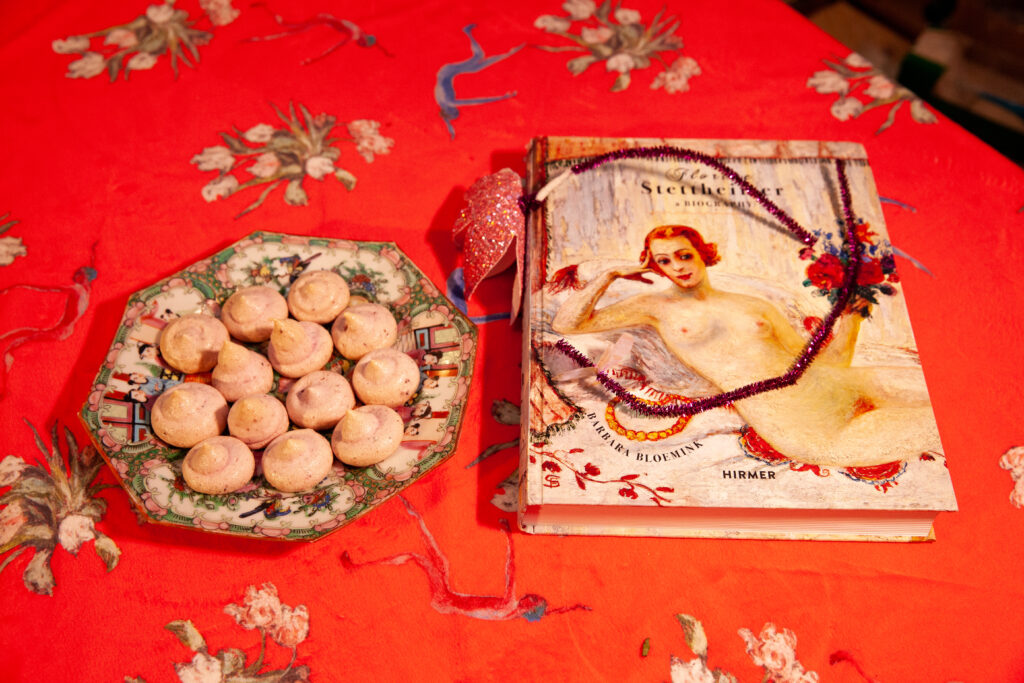
Photograph by Erica Maclean.
The painter and poet Florine Stettheimer should have been easy to cook from. Her poetry, commercially published for the first time in the 2010 collection Crystal Flowers, has a section devoted to “comestibles”—including airy tributes to ham, bread, and tomatoes with Russian dressing—and her paintings often portray food. She was born to a wealthy German-Jewish family in New York in the late eighteen hundreds, part of a social circle that included Neustadters and Guggenheims, and she held salons that were a Who’s Who of the New York art world. (Marcel Duchamp, Carl Van Vechten, and Leo Stein were regulars.) Stettheimer did not oversee the cooking, but part of her work’s deliberate feminine aesthetic involved recording the parties, personalities, dishes, outfits, interiors, furniture, and floral arrangements that made up her life. On one canvas, Soirée, a plate of salad and pitcher of cocktails adorn a table in the foreground of a drawing-room scene, where assembled luminaries gaze at Stettheimer’s paintings-within-the-painting. These were unorthodox choices for a woman artist of her time—many others made strenuous efforts not to seem too overtly feminine.
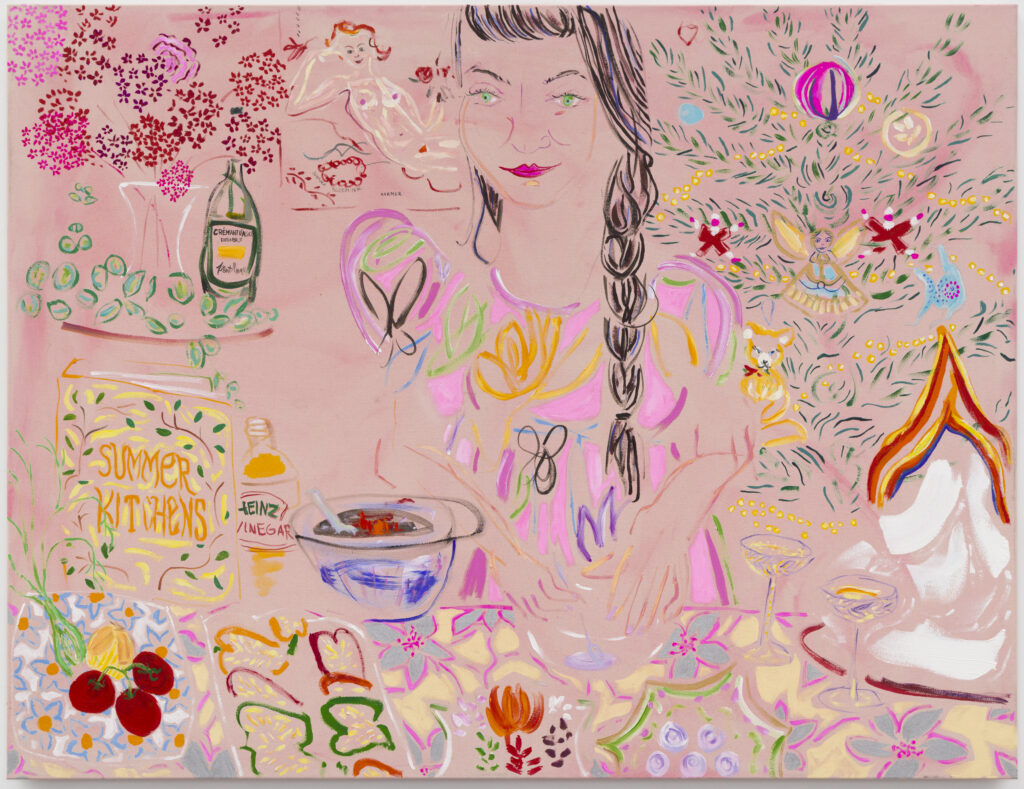
The artist Heidi Howard painted a portrait of me while I cooked from Florine Stettheimer’s work. Notice the stuffed peppers, left, and Baked Alaska, right. Photograph by Erica Maclean.
Yet perhaps this femininity was also subversive. Today’s art world is reevaluating Stettheimer in the wake of the publication of Crystal Flowers and a 2022 biography by Barbara Bloemink, Florine Stettheimer, published by Hirmer. Bloemink situates Stettheimer as a surprisingly modern figure whose “female” topics—furniture and domestic interiors, flowers and frills, diaphanous fabrics, social events, her family, social narratives—were presented both unapologetically and with a wry, critical distance. Through the witty, effervescent tone of her poems and the originality of her painterly technique, she transformed her subjects into baubles for the artist’s gaze—and in so doing, de-gendered them. The following untitled poem is representative: “Mary Mary of the / Bronx aerie / How does your V garden / Grow? / with beans and potatoes / peas and tomatoes / and shiny bugs all in a / Row” is representative. Stettheimer’s choice of wording and image show the poem to be about making art, not salad. The “V garden” is cheekily abbreviated; its rhyming food is aesthetic and playful.
To cook from Stettheimer’s work, then, would be to acknowledge that her interest in food was not literal. In the section “Comestibles,” rhyming ditties, light as meringue, are entry points into discussions of sex and desire. Stettheimer went about this with a frankness unusual for the time period, and with a dollop of irony as well. A “comestible” is alimentary but not elementary; the fancy and fanciful word removes food from the cupboard and makes it more like art, if a bit unconventionally. In one poem, Stettheimer writes: “You stirred me / You made me giddy / Then you poured oil on my stirred self / I’m mayonnaise.” A frothy crush comes to a gluey and unsexy end in a mere four lines. Another untitled poem runs, “You beat me / I foamed.” In the next lines, its subject is “drowned” in sweetness and “parceled” out. She concludes, “You made me hot – hot – hot / I crisped into ‘kisses.’” Here, Stettheimer puts a lover’s attempts at mastering her into her oven and bakes them into female pleasure.
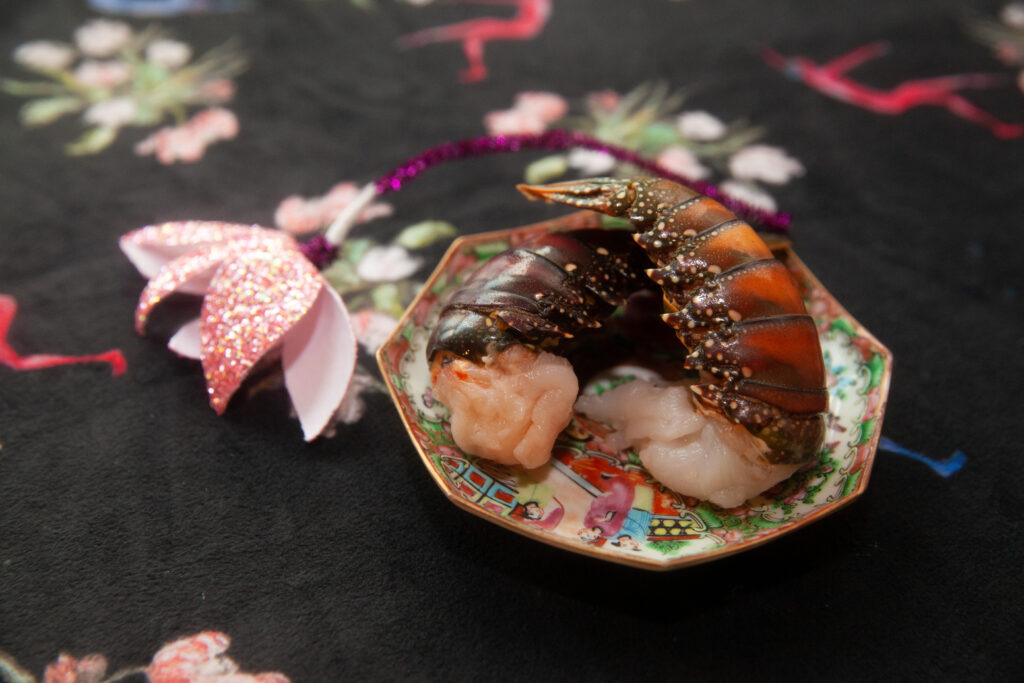
Stettheimer’s sophisticated soirees demanded sophisticated ingredients. I used crayfish tails in the salat Olivye inspired by her poems. Photograph by Erica Maclean.
In order to re-create Stettheimer’s fare, I needed to transform such dishes into something visual and concrete, which seemed beyond the purview of mere food and was complicated by some of the work’s details. Despite Stettheimer’s adulthood in Manhattan, the food her poetry suggests is the stodgy fare of the old world, a reflection of how her family ate. At their homes and country homes, Bloemink wrote in her biography, they consumed elaborate several-course meals, served on fine porcelain. In the “Comestibles” section of Crystal Flowers, there are grandmotherly stuffed peppers and a family staple, the gross-sounding “chaud-froid,” a gelatin sauce made from a reduction of boiled meat. Stettheimer described it as follows: “You are hot / You are cold / Your black beauty spots / Enhance your creamy whiteness.” I considered making dramatic banquet-style versions of these dishes but have not had success in the past with making jellied meat look (or taste) edible. And there were price considerations—I needed veal and crayfish for a salad inspired by the “V garden,” and I couldn’t produce old-world banquet food at new-world prices. The Stettheimers served champagne every night in the family drawing room; I could afford only Crémant d’Alsace, a French sparkling wine produced in the traditional champagne method but in a less expensive region for growing grapes. My spirits consultant Hank Zona found me a good-quality vintage Crémant from Domaine Albert Mann that had a thematically appropriate painting on the label.
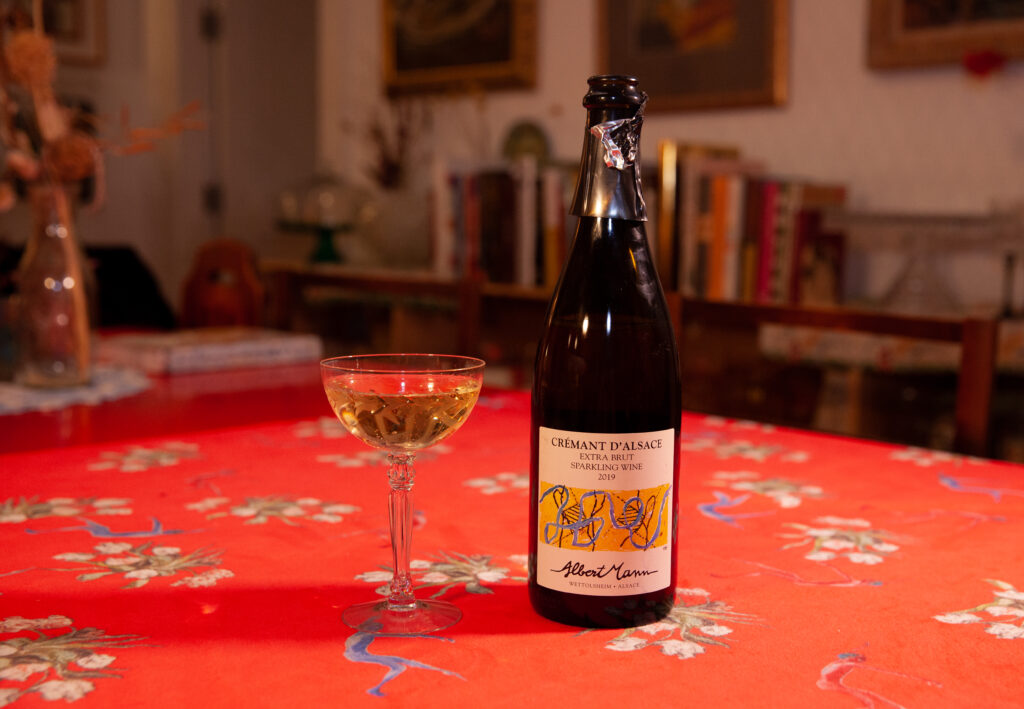
Crémant sparkling wine for the drawing room on a budget. Photograph by Erica Maclean.
And so I turned to the artist Heidi Howard to make my Stettheimer-inspired food into something more. Howard’s style of portraiture documents social spaces, as Stettheimer did, and they are interested in depicting the passage of time in painting, as Stettheimer was. Howard explained to me that portraiture opens up “a new painted space” that creates a conversation between the painter and the sitter, and that offers a more flexible way of existing collaboratively. We decided they would paint me in my kitchen, along with the dishes I’d chosen, the cookbook I’d used, and even the Crémant d’Alsace wine. The profusion of these domestic details, down to my Christmas tree in the background, evoked Stettheimer.
Our time together passed quickly. Howard brought a sixty-inch-by-forty-six-inch prepared canvas to my kitchen. While they painted, I made two old-world dishes that were inspired by the Ballets Russes. I took “Black-Swan Effect Stuffed Peppers,” from the cookbook Summer Kitchens by Ukrainian food writer Olia Hercules, a recipe that swaps the usual meat in the filling for vegetarian-friendly apples. The “black swan” in the title is a reference to the ballet Swan Lake, where a small change (in the coloration of a swan from black to white, as with the swap from meat to apples) makes a huge difference. Second, the vegetables in Stettheimer’s untitled poem about Mary in her Bronx aerie, and the mayonnaise from the other poem quoted above, reminded me of the Russian dish salat Olivye. In its modern incarnation this is a depressing Soviet-buffet standby made with beans, tomatoes, peas, cubed potatoes, cubed ham, and plenty of mayo, but it has roots as an elegant czarist concoction with more elevated ingredients, and this was the direction I aimed for.
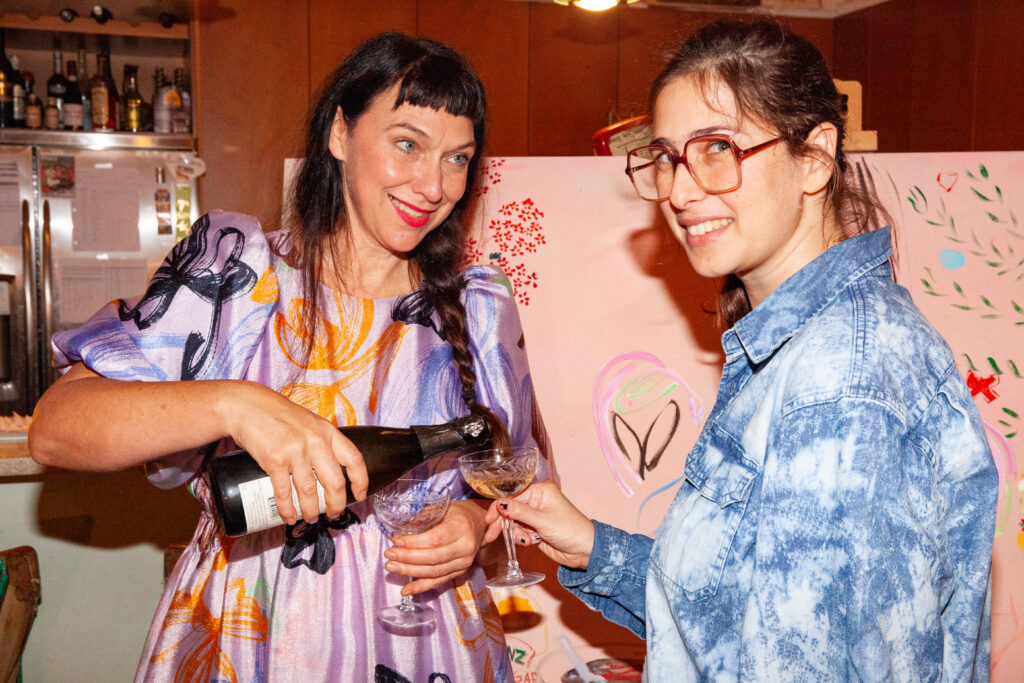
The artist Heidi Howard, at right, was inspired by Stettheimer’s subversive takes on floral arrangements and domestic interiors. Photograph by Erica Maclean.
I took artistic license for dessert. The poem that begins “You beat me / I foamed” and ends “I crisped into ‘kisses’” implies meringue, a material that has some of the glossiness, shine, and plasticity of Stettheimer’s beloved cellophane, which she often wore and painted herself wearing. I made piped-meringue kisses, flavored with freeze-dried raspberry powder and pulverized rosemary. And since the chaud-froid’s hot-and-coldness and mysterious black spots reminded Howard of a Baked Alaska (later revealed to have been a challenge on an episode she’d recently watched of The Great British Bake Off), I made one. In place of the usual sponge-cake base, I used a layer of Russian-style walnut cake.
As I’d suspected, turning Florine Stettheimer’s airy comestibles into food-on-a-plate meant losing something of the artist’s spirit. My stuffed peppers were excellent, but humble. The rosemary-raspberry meringue “kisses” tasted delicious, but after several errors with the piping bag, I wound up with a prudishly small quantity of them, not enough to make anybody “hot – hot – hot.” My salat Olivye was banquet-worthy—I had never made one before, and was surprised at the painstaking demands of its assembly and seasoning. In the end, I forgot ingredients and ran out of time, but the recipe below has been adjusted. An attempt to make my own mayonnaise by hand was an abject failure—I should have known that all the Modernist women bought Hellmann’s.
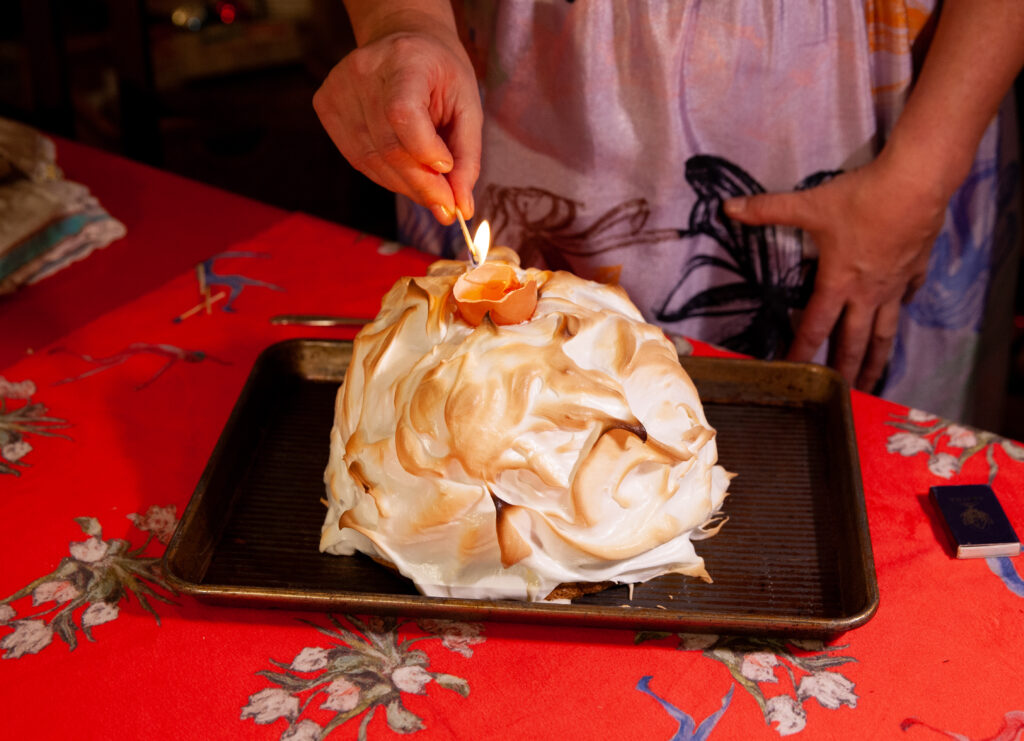
A Baked Alaska makes for a dramatic tableside presentation. Photograph by Erica Maclean.
It was the Baked Alaska that best channeled Stettheimer’s spirit—despite, or perhaps because of, the fact that it was a sticky, flaming, melting mess. Here was a dish, finally, that seemed to transcend mere food and generate a symbolic presence. The painter often depicted herself with huge, vaginal flower bouquets hovering near her genitals, which were simultaneously art-historical in-jokes and a transformation of the vagina’s creative power from vessels for bearing babies to sites of aesthetic production. My dessert was about the same size as the arrangements and had a similar firepower.
To make a Baked Alaska, you line a bowl with plastic wrap, fill it with layers of ice cream, insert a sponge-cake layer as a base, and put it in the freezer to set. Just prior to service, you whip up a pot of sugar and egg whites, decant the frozen Alaska, slather it with the meringue (attractively!), and then set it on fire. The fire is best produced by pouring a ninety-proof alcohol into half an eggshell nestled in the pillowy meringue atop the Alaska, quickly spooning it all over the sides, and then dropping a match into the eggshell. (You could use a kitchen torch instead, but the burnt alcohol imparts a necessary final touch of flavor.)
My Baked Alaska was a giant dome of creamy white, encrusted with sticky little points of wet, uncooked meringue. It was heavy to carry to the table. I had to use more than one match to get it going (messily dropping burnt matches into my meringue), and when it caught fire it flamed aggressively for several minutes, crisping and blackening the final product and truly creating the “beauty spots” of the poem. I thought it stood in well for one of Stettheimer’s blooming vaginal-symbolic arrangements.
When my guests and I cut into it, the following lines about “chaud-froid” applied:
You are delicious
You are a dream
You are full of softness
Full of delicacies
Marvelously blended
I gloat over your perfections
And voluptuously destroy you—
You wonderful hot-cold thing
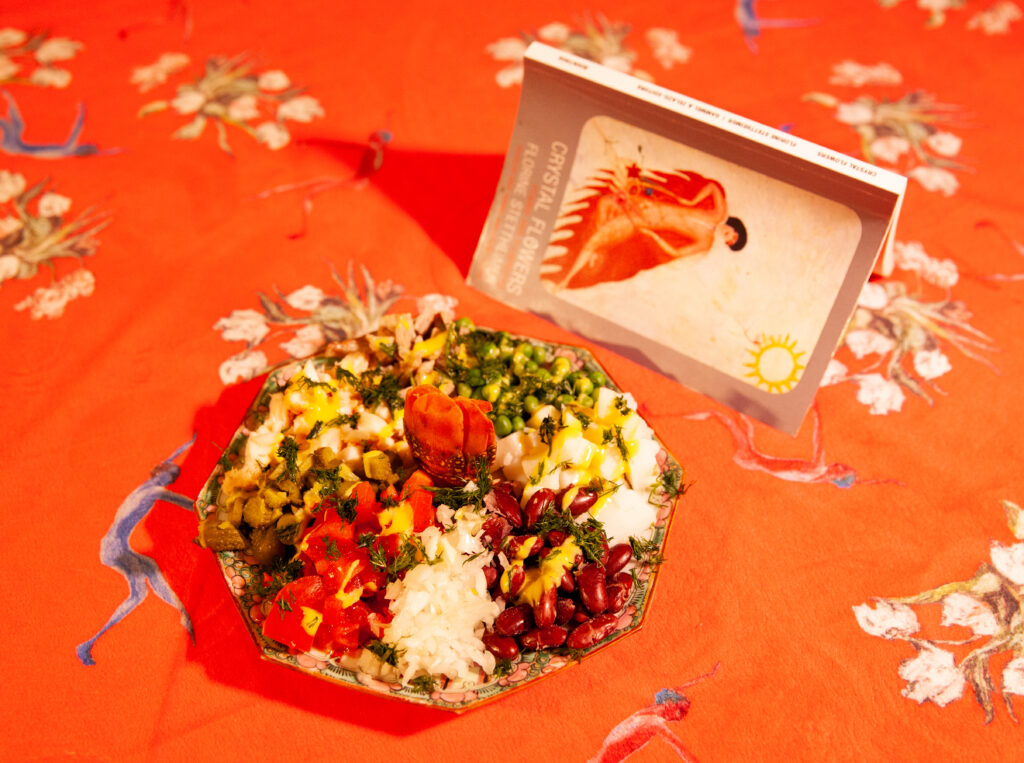
Photograph by Erica Maclean.
Russian Salat Olivye, Imperial Style
You stirred me
You made me giddy
Then you poured oil on my stirred self
I’m mayonnaise
—Florine Stettheimer
Mary, Mary of the
Bronx aerie
How does your V garden
Grow
With beans and potatoes
Peas and tomatoes
And shiny bugs all in a
Row
—Florine Stettheimer
Adapted from The Russian Tea Room Cookbook by Faith Stewart-Gordon & Nika Hazelton.
For the salad:
1/2 cup each of the following items:
crayfish tail, cooked and cubed
veal, cooked, seasoned, and cubed
kidney beans, cooked
potatoes, cooked and cubed
green peas, cooked and cubed
tomatoes, chopped
hard-boiled eggs, cubed
For the dressing:
1/2 cup mayonnaise
1/3 cup sour cream
1 tsp Dijon mustard
2 tbsp pickles, chopped
1 tbsp capers, drained
1 tbsp minced parsley
1 tbsp minced dill
In a large bowl, combine all the elements for the salad. Combine all the elements for the dressing in a small bowl and whisk to combine. Add dressing to taste. Toss, season, and serve.
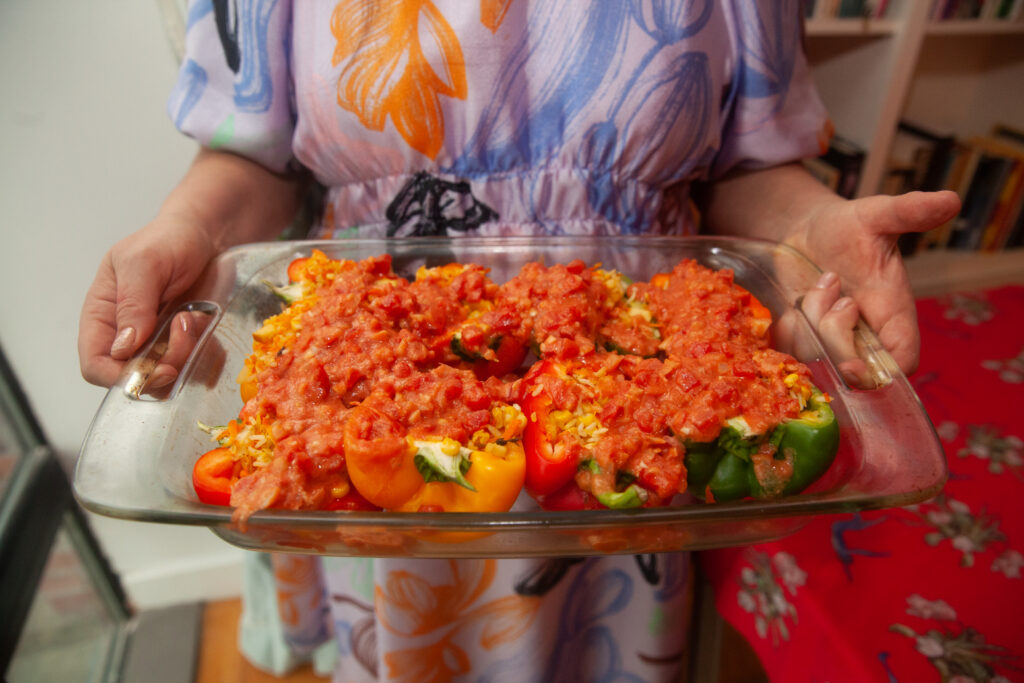
Photograph by Erica Maclean.
“Black Swan Effect” Stuffed Peppers
Your sharpness
Brings tears to my eyes
And only
When I have dug through
To your inner softness
I breathe freely once more
—Florine Stettheimer
Adapted from Summer Kitchens by Olia Hercules.
For the filling:
2 tbsp butter with a splash of oil
1/4 of a fennel bulb, grated
1 large carrot, grated
2/3 cup white or brown rice, cooked
2/3 cup corn kernels
1 green apple, cored and diced
1 tbsp thyme leaves
For the sauce:
2 tbsp butter with a splash of oil
1 onion, thinly sliced
3 garlic cloves, minced
2 large ripe tomatoes (or one 14.5-ounce can of diced tomatoes, pureed in the blender)
1/2 cup heavy cream
3/4 cup vegetable stock
Salt
pepper
a little sugar
To assemble:
4 large bell peppers
salt and pepper
chopped parsley and dill to serve
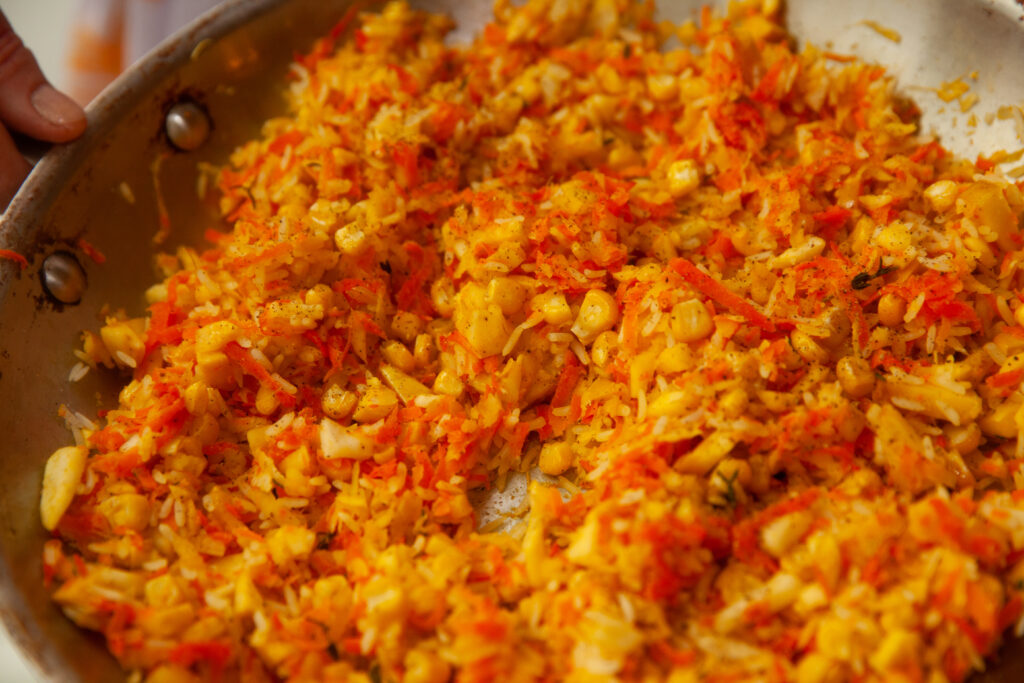
Photograph by Erica Maclean.
To make the filling, heat the butter and oil in a large frying pan over medium-low heat. Add the fennel and carrot and cook until soft, then stir in the rice, corn, apple, and thyme. Season generously with salt and pepper. The filling should be very well seasoned, almost on the verge of being over-seasoned, as it will also serve as seasoning for the peppers.
To make the sauce, heat the butter and oil in a medium frying pan over medium heat. Add the onion and cook for five minutes, stirring frequently, until it begins to soften. Add the garlic, turn down the heat to low, and cook gently for three more minutes, to mellow the flavor. Grate in the tomatoes, discarding the skins, or add the pureed tomatoes, and cook for fifteen minutes, stirring from time to time. Add the cream and the stock and stir. Season with salt, pepper, and a little sugar if it needs it. The sauce should be silky and luscious.
Preheat the oven to 425 degrees Fahrenheit. Cut the peppers in half, seed them, and stuff with the filling. Pour half the sauce into a baking dish that will snugly hold all the peppers. Arrange the peppers in the dish and pour the rest of the sauce on top of them. Cover the dish tightly with a lid or foil and cook in the oven for thirty minutes. Take off the lid or foil and cook for another ten minutes or until cooked through and golden. Do not overcook. Serve topped with parsley and dill.
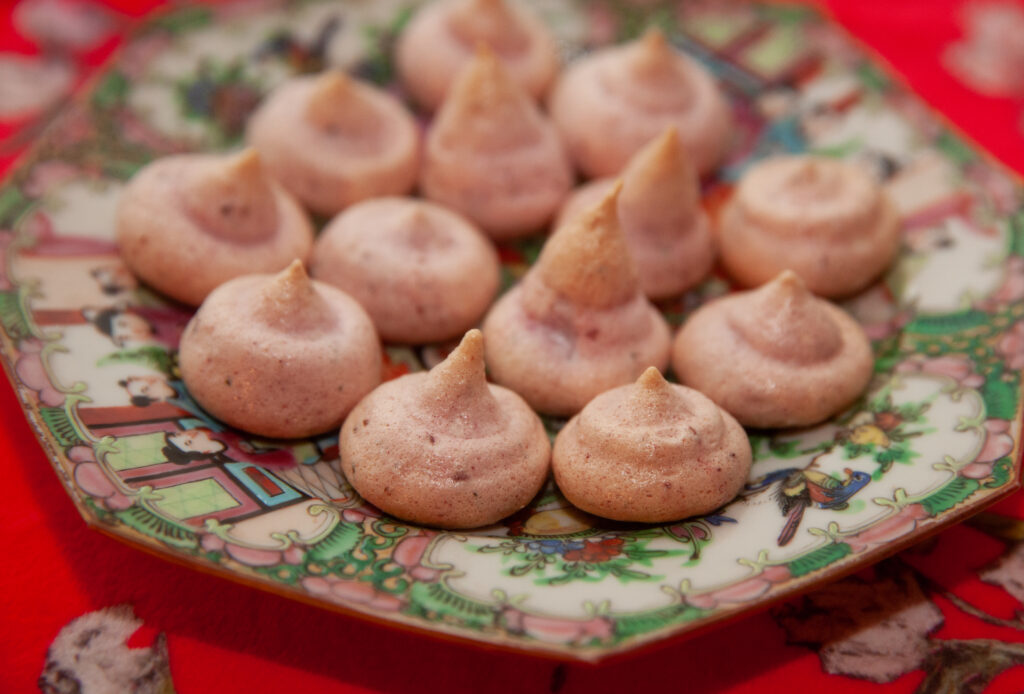
Photograph by Erica Maclean.
Rosemary-Raspberry Meringue Kisses
You beat me
I foamed
Your sweetest sweet you almost drowned me in
You parceled out my whole self
You thrust me into darkness
You made me hot – hot – hot
I crisped into “kisses”
—Florine Stettheimer
4 large egg whites, at room temperature
1/2 tsp cream of tartar
1/2 cup plus 1 tbsp superfine sugar
1/4 cup powdered sugar
1/4 cup freeze-dried raspberries, bashed into powder
1 tsp rosemary, very finely chopped
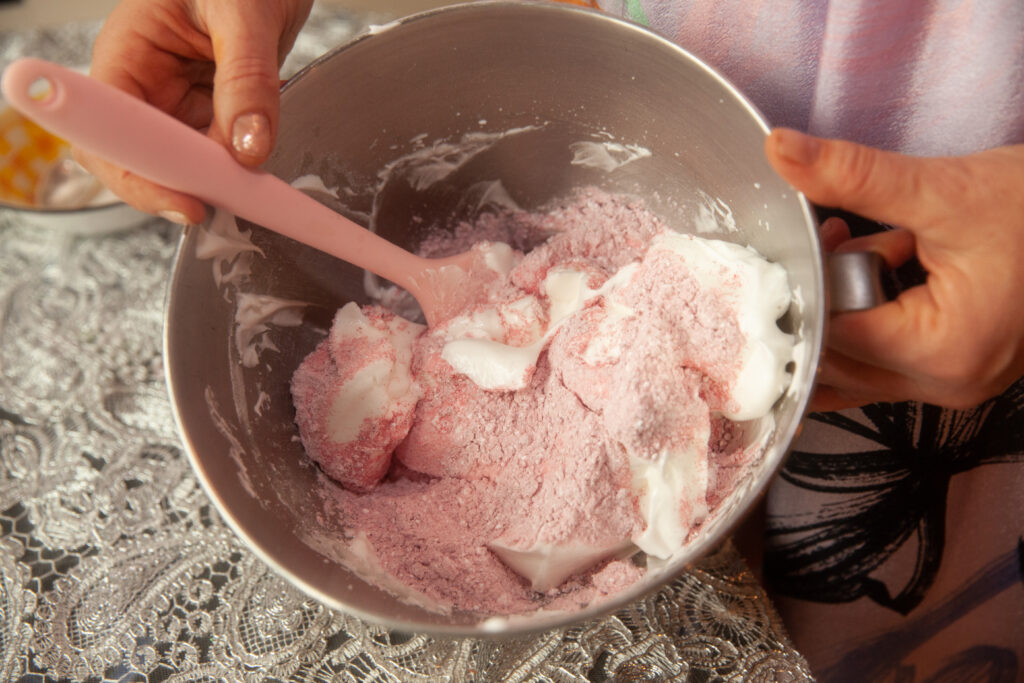
Photograph by Erica Maclean.
Preheat the oven to 200 degrees Fahrenheit. Line a tray with parchment paper and assemble a piping bag fitted with a large cake tip (I used one with a fifteen-mm round opening).
In a mixing bowl, beat the whites until frothy. Add the cream of tartar and beat at medium speed while gradually adding two tablespoons of the superfine sugar. When soft peaks form, add another tablespoon of superfine sugar and increase the speed to high. When stiff peaks form, gradually add the remaining superfine sugar and beat until stiff and very glossy. Gently fold in the powdered sugar, raspberry powder, and rosemary.
Fill the piping bag with the mixture and pipe into “kisses.” Bake for one hour, then turn off the and leave inside to cool for one hour more.
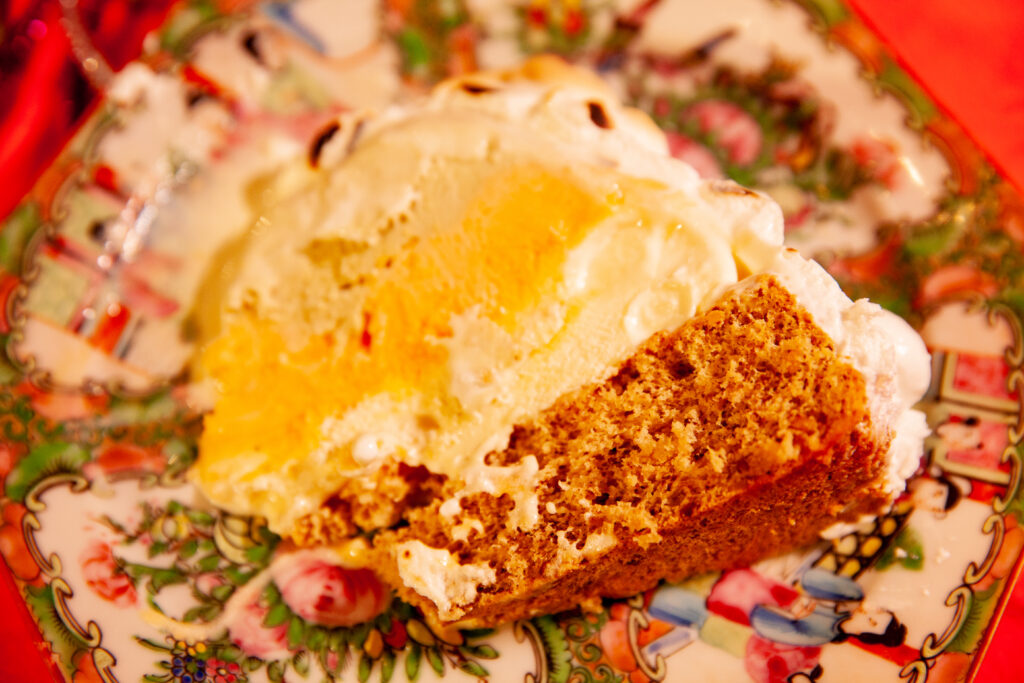
Photograph by Erica Maclean.
Walnut, Orange, and Pistachio Baked Alaska
You are hot
You are cold
Your black beauty spots
Enhance your creamy whiteness
You are delicious
You are a dream
You are full of softness
Full of delicacies
Marvelously blended
I gloat over your perfections
And voluptuously destroy you—
You wonderful hot-cold thing
—Florine Stettheimer
For this recipe you will need an old-fashioned, five-pint metal dessert mold or other deep bowl with a nine-inch round opening.
For the cake layer:
4 large eggs, separated, at room temperature
a pinch of salt
1/8 tsp almond extract
1/2 cup superfine sugar, divided
1/3 cup flour, sifted with 3/4 tsp baking powder
1/2 cup walnuts, toasted and finely chopped
For the meringue:
4 large egg whites, at room temperature
1/2 tsp cream of tartar
1/2 cup plus 1 tbsp superfine sugar
1/2 cup powdered sugar
To assemble:
1 pint orange sherbet, softened
1 pint pistachio ice cream, softened
1 pint vanilla ice cream, softened and mixed with 1/3 cup orange marmalade
2 tbsp rum, vodka, or other alcohol, 90 proof or above
1/2 of an eggshell
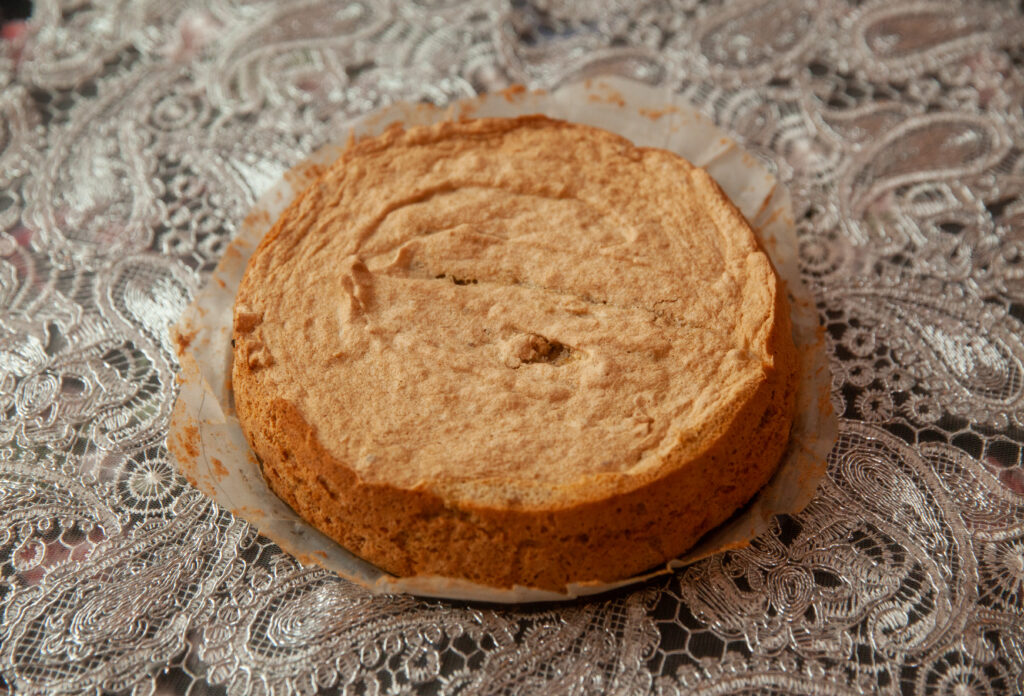
Photograph by Erica Maclean.
To make the cake layer:
For best results, make the cake layer the day before you intend to assemble the Baked Alaska. Set a baking rack in the middle of the oven and preheat to 350 degrees Fahrenheit. Line a nine-inch springform pan with wax paper covering the bottom and coming slightly up the sides, and grease the paper.
In a large bowl using a wooden spoon, stir the egg yolks vigorously with a pinch of salt for thirty seconds. Add the almond extract, stir, and reserve. With an electric beater, whip the egg whites at high speed until soft peaks form, add three tablespoons of the sugar and continue to whip at high speed for two minutes. Add two tablespoons more of sugar, whip until stiff peaks form, add the remaining sugar and beat three minutes longer.
Fold the whipped egg whites, flour, and walnuts into the egg yolks as gently as possible, working quickly but in small batches. This process should take about two minutes altogether. Fill the pan, distributing the batter evenly, and bake for twenty to twenty-four minutes, until the cake turns pale beige and tests done with a skewer. Remove from the oven and let cool.
To make the meringue:
In a mixing bowl, beat the whites until frothy. Add the cream of tartar and beat at medium speed while gradually adding two tablespoons of the superfine sugar. When soft peaks form, add another tablespoon of superfine sugar and increase the speed to high. When stiff peaks form, gradually add the remaining superfine sugar and beat until stiff and very glossy. Gently fold in the powdered sugar.
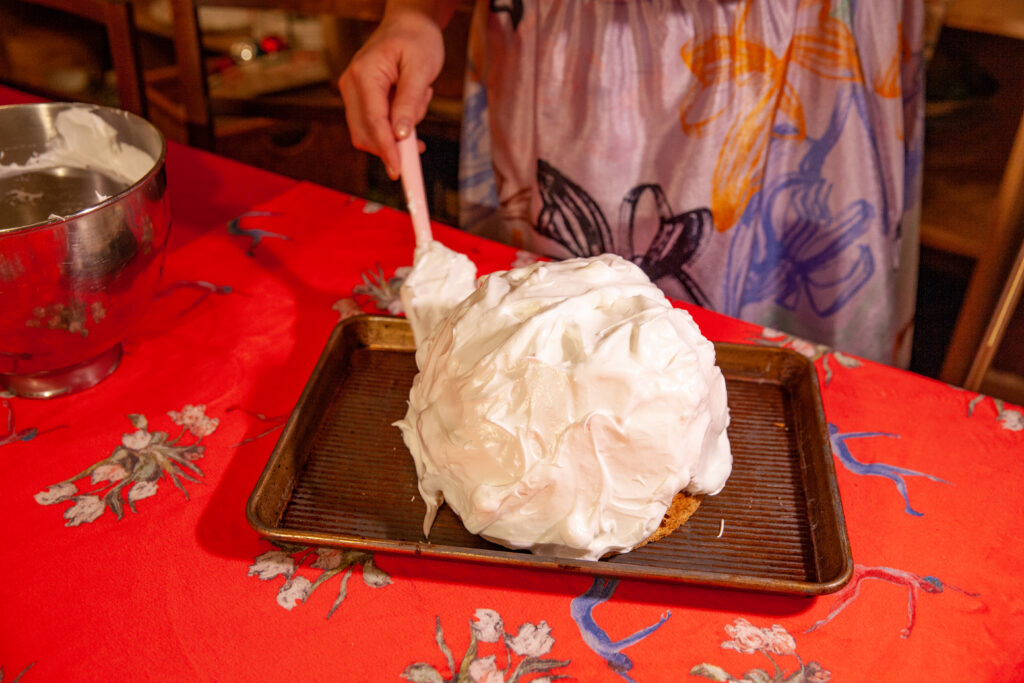
Photograph by Erica Maclean.
To assemble:
Line a nine-inch bowl or dessert mold with plastic wrap. Fill with ice cream in three even layers, leaving an inch or two at the top for the sponge cake. Insert the sponge cake and return to the freezer. When it is time to serve, invert the frozen Alaska over your serving plate and remove the saran wrap. Using a rubber spatula, cover with meringue. Nestle the eggshell on top of the dessert and fill with alcohol. Tableside, just prior to service, quickly spoon the alcohol over the sides of the dessert and drop a match into the eggshell. When the flames have subsided, remove the eggshell, slice, and serve.
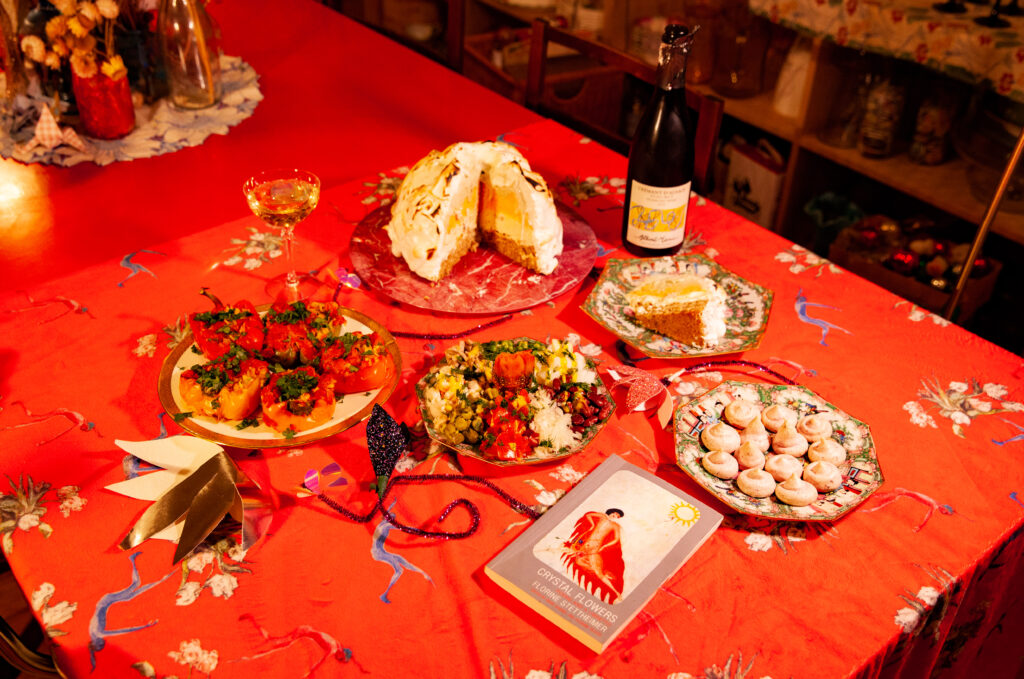
Photograph by Erica Maclean.
Valerie Stivers is a writer based in New York. Read earlier installments of Eat Your Words.
Copyright
© The Paris Review
